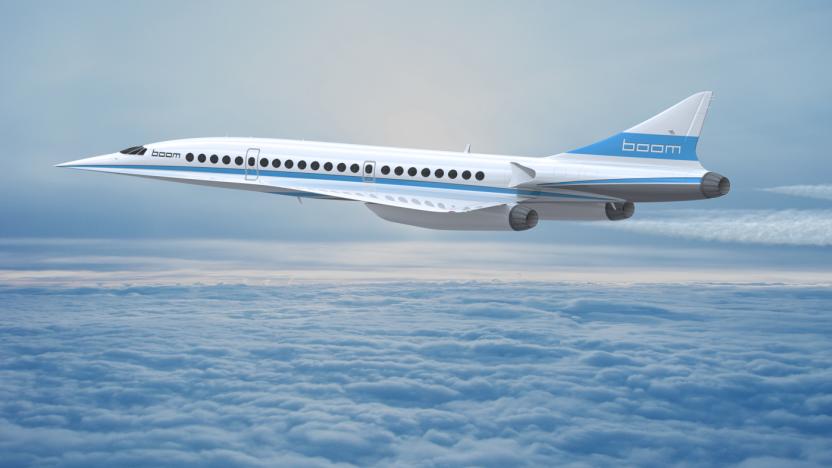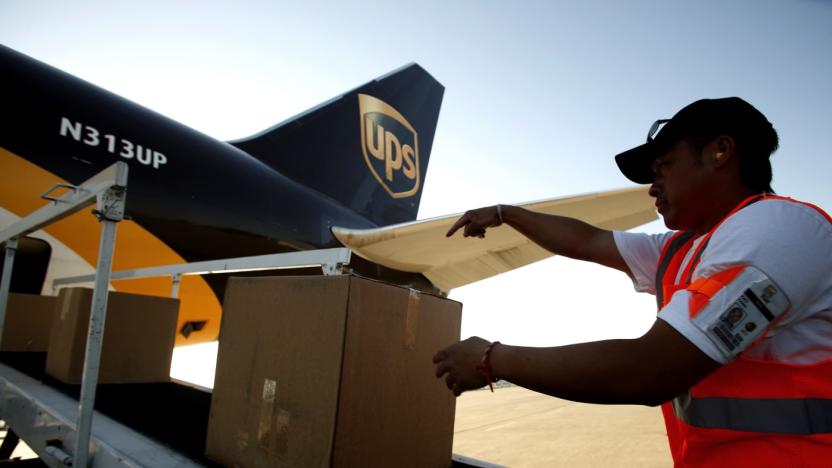jets
Latest

I flew, ever so briefly, with a jet suit
And the first look at its electric prototype of the future.

Scientists recreated Jupiter's chaotic atmosphere in the lab
Many scientists figure that Jupiter has a limited amount of ammonia that is mostly concentrated in the upper atmosphere. However, the Juno probe recently spotted plumes of the gas extending up to 65 miles deep, well below the outer clouds. A team from UCLA and France have created a physical lab simulation they believe helps explain why. By spinning water around in a tank and injecting turbulence, jets formed deep below the surface, much like the plumes Juno detected. The work could lead to computer simulations that help scientists better understand Jupiter data from upcoming Juno orbits.

Boom's supersonic jets will pick up where the Concorde left off
Boom founder and CEO Blake Scholl wants passengers to break the sound barrier. Since the demise of the supersonic Concorde passenger jet, commercial airlines haven't offered a quicker alternative to fly from point A to point B.

Amazon launches 'Prime Air' with a cargo plane, not a drone
The first time we heard about Prime Air it was emblazoned on drones Jeff Bezos showed off for 60 Minutes in 2013. Now Amazon is revealing the logo on a flying machine that operates on a much larger scale. Amazon One is just one of its 11 dedicated planes, and the Boeing 767-300 will be flying this weekend at a Seattle airshow. The company says that maintaining its own air cargo network -- the planes are leased from shipping partners, with plans to expand to 40 over the next couple of years -- will help it keep shipping speeds up.

easyJet's hybrid plane design has a hydrogen fuel cell inside
Aiming to save the European airline money, oh and the environment, easyJet hopes to trial new hybrid plane designs later this year. We're not talking about a new paint job or minor wing design changes, however: the company wants to embed a hydrogen fuel cell into a new hybrid plane design, with aircraft brakes that absorb energy on landing to be reused, even powering the jet through taxiing without using its engines.

Amazon is reportedly leasing jets to power shipping network
Amazon-branded trailers aren't all the online retailer has planned to improve is shipping network. The Seattle Times reports that Jeff Bezos & Co. are in talks to lease a fleet of Boeing jets to handle the air cargo duties. As the company looks to avoid the headaches of using UPS and other carriers, it has already put a group of trailers on the road to carry loads to its distribution centers.

Air Race Speed: Futuristic jet racing with stellar controls
Air Race Speed is a high-speed jet racing game with a futuristic theme. Travel through 36 different tracks in what looks like some sort advanced science lab or factory using one of nine vehicles. Compete with yourself to beat your own high score each time or challenge friends. The game includes multiple controlling options and an important speed boost toggle to cut down on time and improve your ranking. Air Race Speed is available universally for iPhone and iPad for US$2.99. The detailed graphics falsely give the perception that Air Race Speed is a sophisticated game with a thick storyline and varying functions, but it's actually quite straightforward. When you start the game, you get to choose your preferred track and jet. At the very beginning, only one of each is made available so you're forced to follow along and complete tracks to unlock new ones and eventually unlock the other jets as well. I love that the game gives you the option to use either on-screen controls or tilt. People tend to prefer one or the other and sometimes developers don't have a nice fluid tilting mechanism, but I'm happy to report that's not the case in Air Race Speed. I usually prefer on-screen controls for this reason, but tilting the phone was so much fun thanks to its responsiveness. Plus, the removal of on-screen controls means there's more room to view the playing environment. The object is mainly to make it to the finish line for each track as fast as possible, beating any previous records. Once you make it to the finish line you automatically unlock the next track anyway. Air Race Speed is one of those games that doesn't necessarily need a concrete reward to be entertaining, because I personally just found gliding through the various tubes at lightning speed fun on its own. Your speedometer is on the top right. Generally, the very first "Fall Leaf" jet flies at around 115 mph. When in speed mode, it easily excels past 400 mph, but be cautious that the speed boost comes with a lacking ability to control and maneuver your jet. Each vehicle has ratings on a one to five scale for speed, nitro and handling. The Fall Leaf, as the beginner jet, aptly scores just a one for each of these. To unlock other jets, you need to collect certain numbers of stars. You get up to three stars per race based on your performance, similar to Angry Birds. Air Race Speed integrates with Game Center for achievements and challenging other players. Other than that, there's really not much more to Air Race Speed. That's not a bad thing -- in fact, I found that the opposite is true. Air Race Speed manages to be an exhilarating racing title without useless complexities and controls. While bells and whistles appeal to a certain gaming demographic, the best games are ones that are elegant just by successfully executing all of the basics. Air Race Speed is a superb example of this. Grab it for $2.99 in the iOS App Store.

The death of the original jumbo jet, Boeing's 747-400
Later this month, Cathay Pacific's 747 will fly from San Francisco to Hong Kong for the very last time. It's a story we're hearing from nearly every airline still flying the most recognizable passenger jet in aviation history -- rising fuel costs are prompting carriers to ground their fleets, opting to shuttle passengers in more modern (and efficient) airliners instead. Hundreds of 747s still take to the skies every day, but their numbers are dwindling, with Boeing's 777-300ER and 787 Dreamliner, as well as the enormous Airbus A380, picking up the slack. The flagships of yesteryear now litter the desert, with several sites in California serving as a permanent resting place for the plane that was once known as the Queen of the Skies, the Boeing 747-400.

Spike supersonic business jet swaps windows for a wraparound live-view display
We're pretty excited about the Spike S-512 supersonic business jet, but this latest feature could potentially make a three-hour Mach 1.6 hop from New York to London a bit nerve-wracking for uneasy fliers. A post on the company's blog this week describes one of the cabin features, a "thin display screen" that's embedded in the wall. Cameras mounted around the jet's exterior will power a panoramic view, which can also be swapped for other images or content that's more conductive to sleep, such as a solid dark color or a starry night scene. Removing the windows helps Spike trim the plane's weight while also reducing drag, enabling faster speeds and boosted fuel efficiency. We don't expect commercial airliners to follow suit, however, so if flying 1,218 mph in a windowless tube is something that strikes your fancy, you'll need to hop aboard an S-512 after the supersonic jet takes to the skies in 2018.

Navy looks into UV cloak for stealth aircraft
The Navy's invested good money in the F-35 Joint Strike Fighter, which obscures radar waves and redirects engine heat to evade recognition by infrared sensors. But that stealth flier is still vulnerable to another type of detection: UV sensors. The Pentagon recently began soliciting proposals to develop a device that cloaks aircraft from ultra-violet detection systems. The hope is that such a technology could shield aircraft from missile seekers that scan the sky for telltale "UV silhouettes." According to the call for research, the solution could involve a device that disperses a cloud of quantum dots or other materials to veil jet fighters in a shapeless mass of UV shadow. Given that this is a rather daunting task, it's not surprising that the development timeframe and projected cost are still up in the air.

Boeing 787 review: ANA's Dreamliner flies across Japan, we join for the ride
The Boeing 787 Dreamliner is not the largest plane in the world. Nor is it the fastest. It doesn't have on-board showers or full-size beds, nor can it lay claim to the greatest range or sleekest entertainment system in the air. But it will change the way we fly for decades to come. Boeing's latest commercial airliner is several feet wider and longer than the 767, the company's smallest wide-body (twin-aisle) jet, yet it's 20 percent more fuel efficient. Given that fuel is the single greatest operating cost for any airline, savings of that magnitude could return the industry to profitability, and perhaps even usher in lower airfares for passengers. But while the 787's efficiency makes it an attractive option for airlines, it also serves up a more comfortable ride for passengers. We recently had a chance to fly on a domestic round trip between Tokyo and Okayama in Japan aboard an All Nippon Airways (ANA) Dreamliner -- one of the first two ever delivered. Quieter engines, dimmable windows, LED lights, huge overhead bins, an in-flight bar and on-demand entertainment enhance comfort, even during shorter flights, while higher humidity, a greater internal pressurization level and a gust alleviation system to reduce the effects of turbulence help improve the experience behind the scenes. Care to take a ride? Jump past the break to join us on board Boeing's brand new Dreamliner. %Gallery-141809%

Boeing officially delivers 787 Dreamliner to ANA, future of air travel finally arrives
It's the plane so nice, they unveiled it twice. Boeing once again presented its long-awaited and much-delayed 787 Dreamliner to client All Nippon Airways, but this time the goods were officially delivered. After taking the wraps off the airliner early this August, the aerospace company managed to get a flight-ready unit over to its Everett, Washington production plant for a celebratory hand-off. Despite a fit of stops and starts for the line's rollout, Boeing expects to meet ANA's order of its future 55-strong fleet, producing an additional 20 craft for the Japanese airline by 2013's end. If you want to be among the select few to call "First!," you might want to consider booking that Japan-bound vacation now.

Boeing hitches Android to its 787 Dreamliner ride, powers in-flight options with Google juice
Looks like Boeing's decided to get in bed with Android a mile-high in the sky. The aerospace company has exclusively selected Google's mobile OS as the might behind its new class of 787 Dreamliners' in-flight entertainment. Currently in production jets, of which there are over 800 plus orders, will get outfitted with either a Panasonic or Thales model of the 7- to 17-inch screens. And in a strange twist of luxury privileges, first and business class passengers won't get to enjoy the touchscreen tech, as their monitors will be too large and too far out of reach. Instead, an alternate gesture-based control method is being explored by the company for elite travelers, although nothing's been solidified. Don't expect the planes to launch with the typical Android market experience, either -- apparently, "airline-specific apps" are on the way for the nascent fleets' launch. Now, if only they could replace those flight attendants with little green robots.

Boeing presents first Dreamliner 787 to ANA, flights start in September
After years of delays, hacker vulnerabilities, and technical hiccups, Boeing is finally reaching the finish line -- the 787 Dreamliner is ready. The first of the firm's fantasy flyers was presented to executives of All Nippon Airways this week, scoring ANA a dreamy new jet that promises to increase fuel efficiency by 20 percent when compared to similarly sized birds. The 787 owes its fuel savings (and selling point) to a primary structure comprised of 50 percent composite materials by weight; the much larger A380 sits pretty at 25 percent composite, for comparison's sake. Despite the official presentation, the inaugural Dreamliner is still just shy of actual delivery, requiring a few more test flights before beginning domestic service (in Japan) this September.

Visualized: Boeing 747-8 makes its longest flight to date, writes name in the sky
It's always fun to write your name on things -- chalkboards, diplomas, speeding tickets, yellow snow... you know, the usual. The folks at Boeing couldn't agree more, which is why they tasked 747-8 pilots with writing the jet's name in the sky on a flight test across the US. What could be called the "747-8 wuz here" mission is designed to test the outer limits of the jumbo jet in a max endurance operations test. Taking off yesterday morning from Seattle's Paine Field, the jet flew across 18 states in a 747 pattern until it landed on the west coast a little after midnight -- 17 total hours of mayhem. It seems like everything went swimmingly, which means the brand spanking new jet will be sold to Cargolux, a ginormous cargo airline, later this year. The jet writing does somewhat resemble a drunken righty's attempt at left-handed writing, but hey, who are we to judge?

Boeing's biggest jet takes flight, promises lowest 'seat mile' cost of any commercial airliner
Boeing took a huge -- both literally and figuratively -- step in the development of the largest commercial jet in its history when the 747-8 took to the skies for the first time. Granted, the airframe's cargo version has already logged over 1,600 hours up in the air, but putting the 250-foot passenger plane with a 224-foot wingspan -- 19 feet longer and 13 feet wider than the gargantuan 747-400 -- through its first few paces without incident is no small feat. The 747-8 borrows some of the 787 Dreamliner's weight-trimming tech for better fuel efficiency and lower operational costs than older 747s and jumbo jet competition from Airbus. We just hope it didn't inherit the 787's penchant for delays as well. If all goes according to plan, the new jetliner should complete the 600 test flight hours needed for FAA certification in time to deliver the first 747-8s to customers by the end of the year. We doubt airlines will use the plane's extra space to give us shlubs riding coach any more legroom, but at least its improved all-around efficiency should make flying a little cheaper. PR's after the break.

Boeing 787 Dreamliner delayed again, expectations still sky high
That's right, the 787 Dreamliner, which has airlines all aflutter over promises of increased fuel efficiency, has been delayed yet again. Boeing announced yesterday that customers can expect to see the plane in the third quarter of 2011: one in a long line of setbacks that have put it three years behind schedule. However, despite delays, it seems customer confidence hasn't waned. In fact, the New York Times reported that 787 buyers still find a summer release perfectly practical, leading to a three percent rise in Boeing stock. Trouble for the 787 started back in 2008, with the FAA warning of hacker vulnerability, followed by a 2009 discovery of structural weakness, and an on-board fire last November. Even with delays, and cancellation of at least 60 orders, the 787 still has about 850 pre-orders: more than any other mid-size commercial liner in history. So what's keeping the 787 Dreamliner afloat? Well, mostly promises of a 20 percent increase in fuel efficiency, thanks to a design that's 50 percent composite materials. Clearly, testing the 787 hasn't been a dream, but it seems nothing can keep this plane grounded for good.

Visualized: Garmin's G5000 integrated flight deck looks hard to navigate
Still upset that you missed your chance back in '88 to attend NASA's Aviation Challenge? Don't be. Garmin's G5000 fully integrated flight deck is the real deal, and we're certain that you could be looking at one in just a few months. Train up, nab a pilot's license and then convince some sucker to finance a business jet for you -- a minor chore in exchange for dual 12- or 14-inch flight panels with touchscreen control, wouldn't you say?

Call of Duty: Black Ops campaign trailer to debut during Vikings vs Jets games
Monday Night Football fans will be the first to see Activision's brand new trailer for Call of Duty: Black Ops, featuring footage of the game's single player campaign. To tease the trailer airing on ESPN next week, Activision has created a teaser trailer of the trailer, teasing you to watch a longer version of the trailer you just watched.

Inhabitat's Week in Green: surfing renewable energy, hexagonal LEDs, and ultra-efficient aerodynamics
The Week in Green is a new item from our friends at Inhabitat, recapping the week's most interesting green developments and clean tech news for us. This week Inhabitat reported live from the scene of New York Design Week, where we sifted through thousands of new home furnishings and interiors products to bring you the state-of-the-art in green design. Fresh from the floor of the International Contemporary Furniture Fair is this stunning hexagonal crystal LED light, which is composed of glowing geometric blocks that snap together to form a myriad of shapes. We were also impressed by this beautifully finished wood calculator that multiplies its green factor with sustainably-sourced materials. The past week was also surging with developments from the field of renewable energy - first we were excited to see the unveiling of the Oyster 2, an offshore wave-harvesting energy plant that improves upon its predecessor with a simpler design, fewer moving parts, and a 250% increase in energy generation. Google, HP, and Microsoft are also getting into the green energy game with plans to tap an unexpected energy source to run their data centers - cow dung! Google also led the charge towards cleaner energy this week by funding a new type of jet engine-inspired geothermal drill that uses superheated streams of water to bore through previously impenetrable surfaces. Speaking of jets, MIT has just unveiled several ultra-efficient airplane designs that are capable of cutting fuel use by a whopping 70%. The auto industry also received a jolt of energy as Toyota announced a partnership with Tesla that will boost California's flagging economy and likely lead to more affordable iconic electric vehicles. The field of wearable technology saw several innovative advancements this week as well - safe cyclists rejoice, because a group of Indian students have designed a $22 Solar and Wind Powered Bike Helmet. Meanwhile, a group of Colorado State University seniors have designed a medical incubator backpack unit that they believe can reduce baby deaths in medical emergencies. Finally, we shined light on several brilliant advancements from the field of solar technology, starting with China's plans to build the "biggest solar energy production base" in the world. We also looked at the HYDRA, a solar-powered hydrogen fuel cell system that can reportedly generate 20,000 gallons of pure water a day, and green energy got literal with the unveiling of the first leaf-shaped crystalline silicon solar panels.














